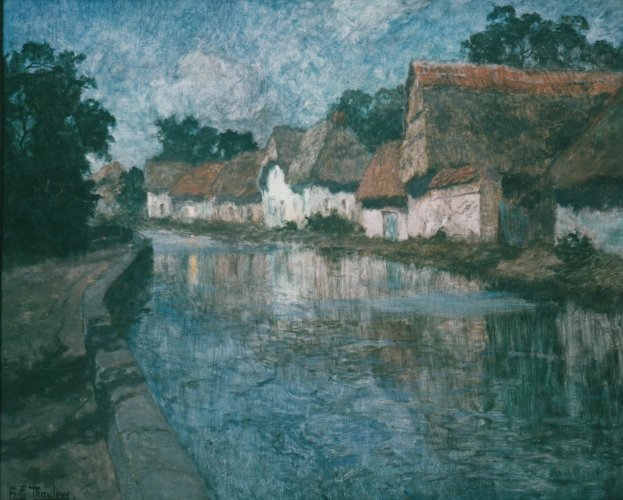Description:
Johan Frits Thaulow (1847–1906) studied at the Academy in Copenhagen and Karlsruhe. Visits to France had a great influence on his work, which encouraged him to set up the “Freilu–ftakademie” to fight against the traditions of academic painting in Norway. Finally he moved to northern France. He became a member of the Société Nationale des Beaux–Arts. The most recurring motif in his art was a river depicted at different times of the day. He was particularly interested in the so–called “blue hour”, the brief moment of dusk when the world is coloured blue.
Description of the painting:
Houses, huddled along the river, adorned with grey thatch, whiten among the dark greens of trees and the muddy blues of the water and the sky. Their reflection lightens up the wrinkled face of the canal on the other side. In one of the houses, lights were lit, which timidly try to disperse the darkness, also thanks to the long reflection in the river. On the stone left bank of the river on the ground and on the wall, the shadow of the invisible trees is arranged, which allows to determine the source of the light, which, however, in view of the darkness prevailing in the image, can be considered lunar. On the other hand, it is difficult to unequivocally deem the painting to be a nocturne. Perhaps this is a record of a very late evening, when shortly before total darkness, the world takes on ever deeper shades of navy.
Observing the light relations that occur in the landscape during the late evening, night or morning was particularly attractive for the artist. Although the landscapes of this Norwegian artist have realistic features, the specific atmosphere in them creates almost a romantic atmosphere. In Norway, Thaulow became famous as a painter who transferred the experiences of the Impressionists to the Scandinavian ground. The paintings often depict winter landscapes in which the painter tried to capture a very short, fleeting moment, the so–called “blue hour“, when after sunset, but before complete darkness, the world is colored in different shades of blue. When he moved permanently to France, he also focused on painting the nature of small towns and French villages, as in the presented view. Rogalinski‘s painting usually depicts the most often painted motif by the painter, i.e. the river, which seems to be a refrain constantly repeated in his work. Thaulow traveled a lot and tried to constantly search for new frames, but ultimately, although from different places, his paintings present similar views. The incredibly suggestive painted surfaces of various rivers fill up successive canvases, becoming mirrors of the artist‘s coloristic searches.


